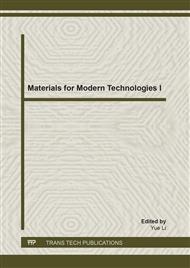p.69
p.75
p.81
p.87
p.95
p.101
p.107
p.111
p.119
Effect of Heat Treatment on the Mechanical Property of PAN-PEO Hybrid Nanofiber Membrane
Abstract:
It is necessary for nanofiber membrane’s application to improve its mechanical properties. In the paper, two spinnerets were used to prepare polyacrylonitrile-polyethylene oxide (PAN-PEO) hybrid nanofiber membrane and then heat treatment was used to improve their mechanical properties.Based on the scanning electron microscopy (SEM) technology the average diameter of the hybrid nanofiber was obtained. After the heat treatment at 100°C, their diameter decrease and the diameter distribution become narrow. It is found that heat treatment can improve the mechanical properties. The nanofiber membrane got mechanical properties with broken stress 17.29 Mpa, broken strain 38.48% and initial module 86 Mpa by treating at 100°C for 1 hour.
Info:
Periodical:
Pages:
95-99
Citation:
Online since:
May 2015
Price:
Сopyright:
© 2015 Trans Tech Publications Ltd. All Rights Reserved
Share:
Citation:


